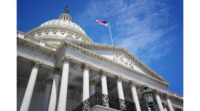The Security Industry Association (SIA) provides numerous services for its members, and one of these services is guidance on how politics affect the security industry. Jake Parker, SIA’s head of government relations, pays close attention to all that is going on in both federal and state governments, and fights for the rights of security businesses both large and small, keeping track of all bills that could potentially impact the industry.
“As an association, we try to translate what’s going on in D.C. into the actual effects on the industry,” Parker said.
As a part of this effort, SIA has a members-only page on its website titled Security Policy Brief where you can look at what legislation the organization is tracking at the federal and state level. SIA also puts out a weekly blog on its website, the Security Policy Digest, that discusses government issues.
To catch up on all that’s been happening on Capitol Hill as of late, SDM spoke with Parker about what legislation is threatening to impact the security industry now.
Infrastructure Modernization
Since the democrats took control of the House and republicans retained control of the Senate in the last election, there has been a lot of talk about bi-partisan work on infrastructure modernization, according to Parker.
And while there hasn’t been a lot of movement on this due to the government shutdown and ongoing debate over border security, a major infrastructure modernization initiative could mean big bucks for the security industry.
“If the bill is broad enough, it is a huge opportunity, because if you modernize any structure, especially critical infrastructure, there’s been so many advances in the industry as far as building security and fire systems that that’s going to by necessity include a lot of newer equipment,” Parker said. “But it’s also kind of a challenge between republicans and democrats; I think democrats are generally going to support a broader measure, and republicans are going to generally support a narrower one, so that’s something they’ll need to work out.”
Parker added that school infrastructure improvement is another area that could see funding this year.
“That’s important because the average age of a school building is 44 years, so with all the emphasis on school security in the last year, there’s a huge need to retrofit security in the older school buildings,” Parker said. “We support the inclusion of schools in [infrastructure modernization] and are hopeful [whatever is passed] will also address those security needs.”
Chinese Tariffs
President Donald Trump’s ongoing trade war with China is the biggest threat to the security industry at the moment, in Parker’s opinion. There are currently 10 percent tariffs on roughly half of the imports from China, including a number of security products that are central to the industry (alarm systems, video surveillance cameras, etc.). These tariffs could potentially go up to 25 percent if no agreement is reached between the U.S. and China.
“At that point we understand that there could be some major changes which would be costly to the industry,” Parker said. “We’ve identified 29 product categories subject to tariffs that are common in the industry . . . If this doesn’t come to a conclusion, it’s going to hurt not only the big companies, but more so the smaller ones, and that’s our biggest concern is how the small integrators are going to be able to cope with increased prices for their products.”
U.S. Ban on Chinese Video Surveillance Products
Related to China but unrelated to tariffs is the prohibition of certain Chinese-manufactured video surveillance products.
“That’s another area that we’ll be helping make sure members have clear guidance from the government on how that’s going to be implemented,” Parker said. “That will likely be in effect by August of this year, so we’re waiting on the rules that we expect sometime as early as next month. Once those come out, we’ll be analyzing them and giving guidance to members.”
Federal Acquisition Supply Chain Security Act
“The new Federal Acquisition Supply Chain Security Act was passed at the end of last year, and while it’s not directly related to the video surveillance ban, it does create a process for contractors and their products where cyber security concerns can be brought forward and mitigated, and it would give authority to a new council instead of the federal government to exclude certain products from federal procurement based on those concerns, or even removing the equipment that’s currently in service,” Parker said.
This act could provide a process by which the manufacturers can be communicated with as far as what the concerns are, and it gives them a way to address those concerns.
Parker said SIA is still learning how this process is going to be implemented over 2019, but that it should be in place within six months. This is an issue especially important for suppliers to the government to be aware of.
Security Updates for Federal Agencies
“SIA represents a number of access control manufacturers that are creating products specifically for the federal government and protecting federal facilities, and the General Accountability Office research arm of congress recently completed a report in December which confirms what we’ve known all along: most federal agencies are not meeting standards for access control and identity management among employees,” Parker said.
This could be another huge money making opportunity for the industry, if the government does decide to invest in these much needed updates. Parker said SIA is hoping for some kind of initiative to make security a higher priority within the government agencies, and that the organization is working on allocating funding for these updates.
Private Security Uses of Counter-UAS Technology
One of SIA’s top legislative priorities for this year is supporting new initiatives aimed at eventually allowing private security uses of counter-UAS technology to protect critical infrastructure, particularly privately owned or operated facilities like fuel refineries, power stations, etc.
“The security industry is rapidly adopting capabilities to provide UAS and counter-UAS technologies for both private and public sector customers,” Parker said. “However, outdated regulations and legal uncertainties have hindered the adoption of counter-UAS technology beyond detection and tracking, which does not fully address the risk from hostile drones.”
Parker added that such initiatives would build upon passage last year of the Preventing Emerging Threats Act, supported by SIA, which provides DOJ and DHS specifically with new legal authority to counter UAS threats to covered facilities or assets using measures such as physical removal, GPS jamming, radio disruption, etc.




